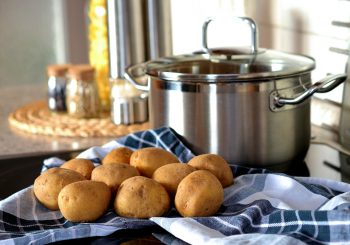Kitchen Fun Posted by Bjørn A. Bojesen on Sep 30, 2018 in Uncategorized
Køkkenet (the kitchen, also spelt køknet) is the heart of a Danish home. When rain is falling from a grey sky – and eating out feels a bit too complex and pricey – it’s great for familien (the family) or vennerne (friends) to gather around spisebordet (the dining table).
Traditionally, husmødre (housewives, singular husmoder) were responsible for madlavningen (the ”making of food”, the cooking). Nowadays, of course, both men and women take turns preparing aftensmad (dinner, literally ”evening meal”).
Many Danes spend a lot of penge (money) to have a large and shiny køkken. Although some people do keep their dining table and stole (chairs) in another room, it’s very common to eat one’s måltider (meals) in the kitchen itself. A samtalekøkken (”conversation kitchen”) is a big, open kitchen that is especially suited for socialising.
A kitchen in Denmark typically has a køleskab (fridge, literally ”cooling cupboard”) to conserve madvarer (foodstuffs), a fryser (freezer) to keep things like ice-cream from melting, skabe og skuffer (cupboards and drawers) to store tools, a køkkenvask (kitchen sink) with vandhane (faucet/tap) to get vand [van] (water), a køkkenbord (work top/kitchen counter) to prepare food, an emhætte (cooker hood) to catch damp (steam), and a komfur [komFOOR] (electric stove/cooker) to heat the food… And yes, Danes too get lazy and buy a mikrobølgeovn (micro wave oven)! 🙂
Let’s prepare some kartofler (potatoes). You’ll need a kartoffelskræller (potato peeler) to skrælle (peel) them and maybe a kniv (knife) and a skærebræt (cutting board)… Del dem i to eller skær dem i skiver eller terninger. (Split them in two parts or cut them into slices or squares.) Put them in a gryde (pot) with kogende vand (boiling water), add salt and stir with a grydeske (ladle). (Remember to turn off kogepladen, the hotplate, when they’re done!)
You can also stege (fry) them in fedt (fat) on a stegepande (frying pan), rive (shred) them on a rivejern (grater), bage (bake) them in ovnen (the oven) with the krydderi (spice) of your choice, or mose (mash) them with an piskeris (whisk) or håndmixer (hand-held mixer) in a skål (bowl).
When you’ve eaten, place the tallerken (dish), gaffel (fork), kniv, ske (spoon), glas (glass), kande (mug), si (sieve), grydelåg (saucepan lid) etc. in opvaskemaskinen (the dishwasher). Finally, clean the dug (table cloth) with a klud [clooth] (cloth)…
Of course, a lot of the fun in a kitchen comes from doing stuff sammen (together). Why not use your next kitchen session to practice your Danish?
Starting in October, this blog will appear only once a month. Stay tuned for new posts about Danish language and culture!

Build vocabulary, practice pronunciation, and more with Transparent Language Online. Available anytime, anywhere, on any device.




